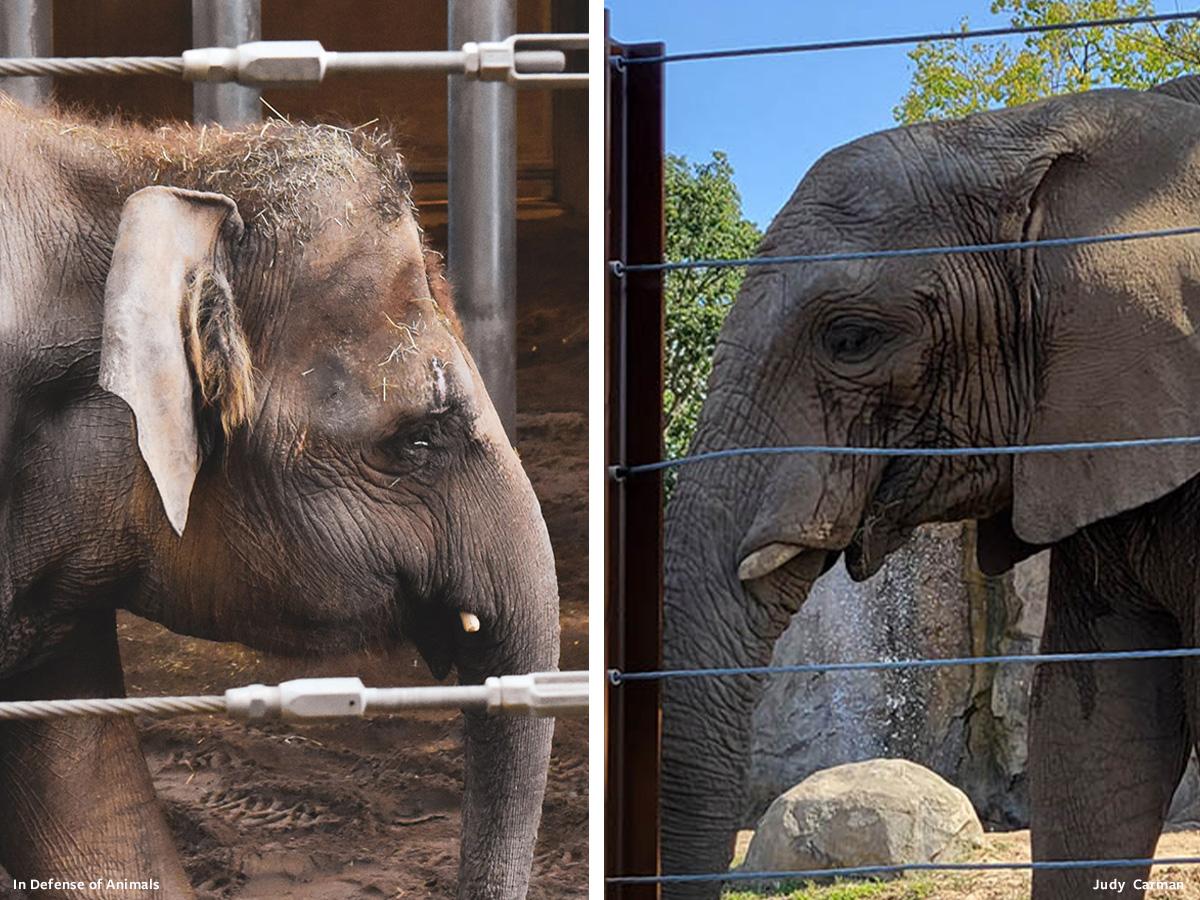The 10 Worst Zoos List Changes Hearts and Minds
How much space does an elephant need to be an elephant? It is probably no surprise to you that no zoo can provide anywhere close to enough space to remotely satisfy the complex needs of elephants. Even in newly expanded exhibits, elephants continue to suffer and die from living in cramped, barren wastelands where they experience lives of quiet desperation.
You can help us to spread this message far and wide so the lie about bigger elephant exhibits is revealed for what it is, a cruel deception to fool the public into supporting the confinement of more elephants for life. In our 2022 10 Worst Zoos for Elephants list we highlight a new scientific study that details exactly why that is and exactly how much space elephants need to live like the wild animals they were born to be.
Your financial support has made it possible for us to publish the 10 Worst Zoos for Elephants for the past 20 years. This list and our other elephant advocacy efforts have resulted in some remarkable successes:
- In Defense of Animals secured the transfer of five elephants to elephant sanctuaries
- San Francisco and 32 other zoos have closed their elephant exhibits
- In Defense of Animals helped with the passage of a bullhook ban in California, ending a decades-long practice of barbaric punishment of elephants
Our work continues to expose the hidden suffering of elephants in zoos.
Because of the profound lack of sufficient room in zoos, elephants suffer from physical and mental illnesses. Fatal foot disease and arthritis, depression, boredom, and even brain damage are just a few of the dire conditions elephants face in zoos from lack of space. Despite this, the space problem is for the most part ignored by zoos, governments, and the industry that regulates zoos. But at In Defense of Animals, we are on the front lines exposing the lack of space, along with all the other deprivations that elephants suffer in zoos.
Your support allows us to counter the massive PR propaganda spewed by zoos. We expect a lot of pushback from zoos that claim their new “Elephant Lands,” “Tembo Camp” or “African Adventure” are spacious havens for their elephants. We experience pushback from zoos from all of our reporting on the 10 Worst Zoos for Elephants. But we know from our extensive research and eyewitness accounts, that these $10 to $58 million expansions do little to nothing to improve the lives of elephants, who despite getting a few extra acres, continue to pace and bob, continue to suffer from zoo-related diseases and continue to die at significantly younger ages than their counterparts in the wild.
These minuscule and barren exhibits lack everything elephants love; trees they can touch (trees are wire wrapped inside exhibits), plants, roots, and grasses they can browse on, and varied supple terrain that cushions and exercises their feet and bodies. Many elephants spend their days standing at the fences that hem them in, just staring out at the lush foliage and vistas that are out of their reach.
To effect change for elephants, we started the 10 Worst Zoos for Elephants list 20 years ago in 2003. With the help of local, national, and international media that publish our findings, we reach a broad audience of concerned citizens who in turn spread the word about the suffering of elephants in their local zoos. We are happy to report there is some progress. So far, 34 zoos have closed their elephant exhibits and three have pledged to close after their last elephant dies.
Please assist us in this vital effort to end the incarceration of these majestic, intelligent, social, and sensitive beings for life in small, cramped, and sterile environments.
Living in tiny zoo exhibits is a nightmare for elephants
Chendra and Shine at the Oregon Zoo are both victims of aggressive bullying, a result of pent-up frustration from elephants living in what is the equivalent of a bathroom to them for their entire lives. They have nowhere to escape in their barren 3-acre exhibit.
The three female elephants at the Cincinnati Zoo suffer the same plight as the Oregon Zoo elephants. Our investigator exposed brutal bullying between two of the females stuck inside a tiny steel enclosure.
Elephants at the Houston Zoo display severe stereotypical behavior. Clearly, the few acres added to their exhibit have proven to be no improvement to their quality of life.
Your support over the years has enabled us to bring about amazing victories
What In Defense of Animals has achieved for elephants starting in 2002:
- IDA filed a lawsuit that essentially blocked the importation of elephants from India, preventing a precedent that could have opened the floodgates for the import of Asian elephants into U.S. zoos and circuses.
- IDA secured the transfer of five elephants to elephant sanctuaries
- IDA supporters helped to achieve passage of a bullhook ban in California
- With the support of Dr. Marc Bekoff, IDA established World Zoothanasia Day to honor the death of Packy the elephant at Oregon Zoo
- Buffalo Zoo shut down its miserable elephant exhibit after appearing five times over the last ten years on the 10 Worst Zoos for Elephants.
- After the 2018 list came out, the Oregon Zoo stopped using bullhooks in public and forcing the elephants to perform tricks, as it had been doing prior to the publication of the list.
- In 2021 the Fort Worth Zoo and African Lion Safari, the #1 and #2 worst zoos, canceled an abusive transfer which would have ripped elephant families apart following the publication of the 10 Worst Zoos list.
What your donation helps us accomplish for elephants:
Our investigations of these facilities include:
- Conducting covert in-person assessments
- Reviewing thousands of government and veterinary records
- Consulting with elephant experts to rebut zoo propaganda with scientific fact
It is a daunting challenge to counter the well-financed zoo propaganda. But despite pushback from zoos, with your support, and starting with your generous donation, we pledge to continue this vital mission to free elephants from the living hell of tiny barren zoo habitats, bereft of everything elephants need to live as they were born to live, as wild and free as possible.


